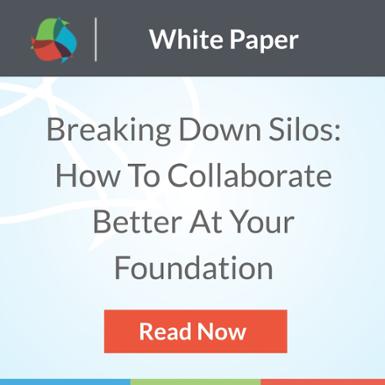 Philanthropy is changing. A new guard of social sector leadership is establishing a new way of working that maximizes impact and efficiency by promoting technology, transparency, and willingness to learn.
Philanthropy is changing. A new guard of social sector leadership is establishing a new way of working that maximizes impact and efficiency by promoting technology, transparency, and willingness to learn.
The key to this new way of thinking is collaboration — and this goes beyond the ease with which technology allows us to convene, share, and work together. And it transcends age: You don’t have to be a Millennial to understand the power of information sharing.
More and more the philanthropic sector is seeing that when foundations collaborate with each other and the nonprofits they fund, they can solve interdisciplinary problems with cross-cutting solutions.
Importantly, collaboration can and should be happening inside a foundation, too.
While this kind of collaboration might seem like a micro-level approach, change begins at home. At many foundations, disparate program areas run with relative autonomy and sometimes forget to peek over the wall and see what everyone else at the foundation is doing. But by lifting out of the day-to-day and tapping into the valuable resources available to you at your own foundation and in other program areas, you may be able to learn valuable lessons for your own program.
With that in mind, we created a list of the three best ways to break down silos at your foundation to maximize your impact:
- Encourage a Culture of Sharing We spoke with program staff members at different foundations who acknowledged that the thought of peeking over the proverbial cubicle wall seemed like a big ask. However, once they took the leap, they realized that taking the time to share and collaborate with other teams improved their grantmaking.
- Allow Staff to Take on Different Roles “Accidental techies” at foundations can foster a movement toward collaboration across programs. Ash Shepherd, education director at NTEN, says that the best way to uncover one’s colleagues’ hidden tech expertise is to literally “throw out a question and see who answers.” According to Shepherd, “secret knowledge is tucked away in each staff member.” A bookkeeper may have developed an advanced social media strategy, or a program officer could have a great deal of experience building CRM databases.
- Share Data Sharing findings, lessons learned, and other important data should be a thoughtful and collaborative exercise. Anil Patel, managing director of digital strategy at GrantBook, believes that sharing data is like sharing good food. To “make data accessible, relatable, and easy to share,” Patel says, “you have to put in the right proportions of information.”
Patel recommends organizing a hackathon: Pull team members from across programs, and have them work together to think backward. Throw questions out: Has anyone used a particular dashboard to illustrate impact? Has one team used data to make a successful case for implementing different kinds of grantmaking, such as capacity building over programmatic grants?
But why break down silos within foundations only? Foundations can create a model for the social sector as a whole. When foundation program staff collaborate by sharing and working together across programs, they should also make a point of encouraging their grantees to follow their lead, and engage other foundations to achieve common goals. Just as partnerships across program staff maximize foundation impact, partnerships across organizations can maximize sector-wide impact.
Read the complete guide to Breaking Down Silos at your foundation.